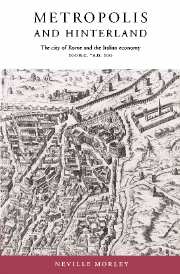Book contents
- Frontmatter
- Contents
- List of maps and figures
- Preface
- List of abbreviations
- Introduction: Rome and Italy
- 1 The metropolitan city in a pre-industrial economy
- 2 The demographic burden
- 3 A model of agricultural change
- 4 The transformation of the Roman suburbium
- 5 Agricultural development in central Italy
- 6 Exploiting the margins
- 7 Marketing and urbanisation
- Conclusion
- Bibliography
- Index
1 - The metropolitan city in a pre-industrial economy
Published online by Cambridge University Press: 17 August 2009
- Frontmatter
- Contents
- List of maps and figures
- Preface
- List of abbreviations
- Introduction: Rome and Italy
- 1 The metropolitan city in a pre-industrial economy
- 2 The demographic burden
- 3 A model of agricultural change
- 4 The transformation of the Roman suburbium
- 5 Agricultural development in central Italy
- 6 Exploiting the margins
- 7 Marketing and urbanisation
- Conclusion
- Bibliography
- Index
Summary
In one sense, all cities are consumers. The existence of urban centres depends on the ability of farmers to produce a regular agricultural surplus, and on the efficiency of economic, social and political institutions in mobilising this surplus for the use of a population which is not involved in primary production. Of course, this broad statement covers a wide variety of possibilities; in the modern industrialised world only a tiny proportion of the population is involved in agriculture, whereas in a pre-industrial, agrarian economy the figure may be 90 per cent or more. Chemical fertilisers and a mineral-based energy economy have transformed modern agriculture, and coal, oil and electricity have revolutionised the distribution of foodstuffs. In a pre-industrial society, surpluses are small and precarious, and transport is slow and expensive; cities are therefore wholly dependent on the performance of agriculture and the vagaries of the climate, and endemically vulnerable to food crisis.
However, the notion of the ‘consumer city’ implies much more than this basic dependence on agriculture. In part, it and its sibling concept (the ‘producer city’) are concerned with the economic aspects of the relationship between city and countryside: the means by which the agricultural surplus is mobilised for the use of the urban population. The producer city pays for its keep through trade, manufacture and providing services to the countryside; the consumer city takes what it needs in the form of taxes and rents, offering little in return besides indifferently administered justice and government.
- Type
- Chapter
- Information
- Metropolis and HinterlandThe City of Rome and the Italian Economy, 200 BC–AD 200, pp. 13 - 32Publisher: Cambridge University PressPrint publication year: 1996

